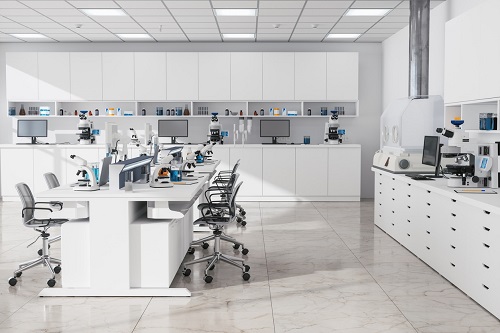Choosing the correct laboratory furniture is crucial to creating an efficient and safe workspace. When deciding between fitted and flexible laboratory furniture, there are several factors to consider. Below is a guide to help you make an informed decision:
1. Nature of Research:
-
Fitted Furniture:
- Ideal for specialized and dedicated workstations.
- Suited for laboratories with fixed and specific research requirements.
-
Flexible Furniture:
- More adaptable to changing research needs.
- Suitable for multi-disciplinary labs where research demands can evolve.
2. Flexibility and Adaptability:
-
Fitted Furniture:
- Limited adaptability, as it is designed for specific functions.
- Changes may require significant renovations.
-
Flexible Furniture:
- Easily reconfigurable to accommodate changing research demands.
- Allows for quick adjustments without major renovations.
3. Cost Considerations:
-
Fitted Furniture:
- Higher initial cost due to customization.
- Long-term savings if research needs remain stable.
-
Flexible Furniture:
- Lower initial cost.
- Potential for higher long-term costs if frequent modifications are required.
4. Space Utilization:
-
Fitted Furniture:
- Efficient use of space, as it is designed for specific functions.
- May lead to underutilized space if research needs change.
-
Flexible Furniture:
- Adaptable to varying space requirements.
- Allows for efficient use of space in dynamic research environments.
5. Ease of Maintenance:
-
Fitted Furniture:
- Generally easier to clean and maintain due to fixed designs.
- Maintenance may be more challenging if changes are required.
-
Flexible Furniture:
- Requires regular maintenance to ensure stability after reconfigurations.
- Easy to clean and maintain in its current configuration.
6. Durability and Longevity:
-
Fitted Furniture:
- Durable if well-designed and constructed.
- May have a longer lifespan if research needs remain constant.
-
Flexible Furniture:
- Durability depends on the quality of materials and construction.
- May need replacement sooner if frequent reconfigurations cause wear.
7. User Ergonomics:
-
Fitted Furniture:
- Tailored to specific tasks, providing optimal ergonomics.
- Limited adaptability for individual preferences.
-
Flexible Furniture:
- Offers flexibility for users to adjust workspaces to their preferences.
- Allows for ergonomic customization based on user needs.
8. Future Expansion:
-
Fitted Furniture:
- Difficult to expand without major renovations.
- May require significant investment for expansion.
-
Flexible Furniture:
- Easily expandable or reconfigured to accommodate new equipment or research needs.
- Cost-effective for labs expecting future growth.
9. Aesthetics and Branding:
-
Fitted Furniture:
- Provides a cohesive and professional appearance.
- Reflects a consistent lab identity.
-
Flexible Furniture:
- Aesthetic appeal may vary with different configurations.
- Lab identity may be more dynamic and adaptable.
10. Compliance and Safety:
-
Fitted Furniture:
- Compliance may be easier to achieve for specific regulations.
- Fixed designs may enhance safety for certain processes.
-
Flexible Furniture:
- Compliance requires careful consideration during reconfigurations.
- Safety features should be integrated into adaptable designs.
Conclusion:
The choice between fitted and flexible laboratory furniture depends on the specific needs of your laboratory. Consider the nature of your research, budget constraints, future growth plans, and the level of adaptability required. A balanced approach that combines elements of both fitted and flexible furniture may also be a viable solution for some laboratories. Regularly reassess your requirements to ensure that your laboratory furniture continues to meet the evolving needs of your research environment.







 (2).png)
.png)


 (1).png)
.png)